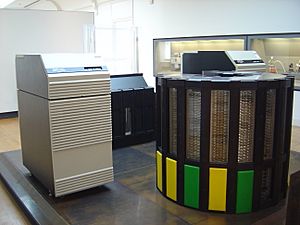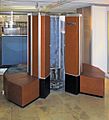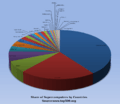Supercomputer facts for kids
A supercomputer is a very powerful computer. It has amazing speed and a lot of memory. These special computers can do tasks much faster than other computers from the same time. They are often thousands of times quicker than regular personal computers.
Supercomputers are great at doing many arithmetic calculations very fast. This makes them useful for things like predicting the weather forecast or breaking secret codes. They also help with genetic analysis and other jobs that need a huge number of calculations. As technology gets better, regular computers become more powerful. But supercomputers always stay ahead, doing even more amazing things!
Electrical engineers design supercomputers. They connect many thousands of tiny microprocessors together to make them work.
Contents
How Supercomputers Work
Supercomputers are built in different ways to handle huge amounts of information. They use special methods to work on many tasks at the same time.
Some supercomputers use a "shared memory" system. This means many parts of the computer can all access the same memory at once. It's like a big shared whiteboard where everyone can write and read information very quickly. This method is called parallel computing and pipelining. Examples include the CRAY series and NEC's SX-3.
Distributed Memory Supercomputers
Other supercomputers use "distributed memory." Here, the computer is made of many smaller parts, called "nodes." Each node has its own memory. They talk to each other to share information. Imagine a team where each person has their own notebook, but they pass notes to each other to work together. These supercomputers can have hundreds or even thousands of nodes. Examples are nCube 3 and Paragon XP/S.
Array Supercomputers
"Array" type supercomputers arrange their processors in a grid or pattern. This helps them work on many pieces of data at the same time. The ILIAC computer, started in 1972, was an early array type. Newer ones like the Mas Par MP-2 also use this design.
History of Supercomputers
The idea of array-type computers began in 1972 with the ILIAC. Since then, computers like the CF-11 and CM-2 were developed. More recently, array-type supercomputers have become very important. There are also new types that combine ideas from shared and separate memory systems, like the T3D and Tera Computer.
See also
Images for kids
-
IBM's Blue Gene/P supercomputer at Argonne National Laboratory uses over 250,000 processors. It's grouped into 72 cabinets connected by a fast optical network.
-
A wide-angle view of the ALMA correlator.
-
This picture shows how a grid computing system might connect many personal computers using the internet.
See also
 In Spanish: Supercomputadora para niños
In Spanish: Supercomputadora para niños










